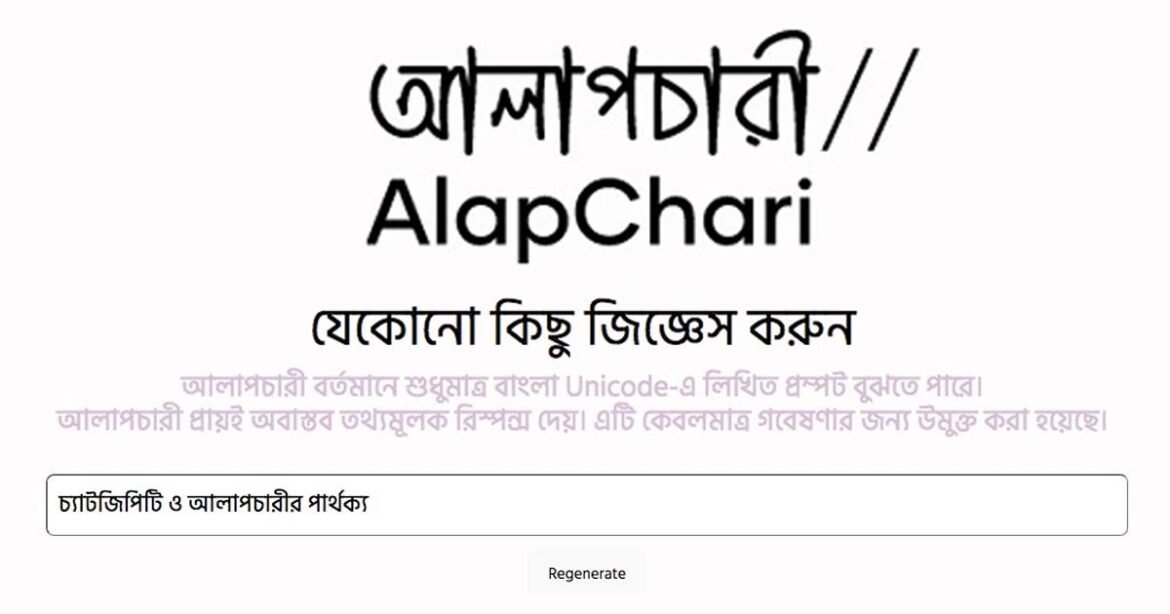Using the same language paradigm as ChatGPT, we have now a Bangla AI-powered chatbot called “AlapChari”.
Almost all of us have heard about this revolutionary tech which has stormed the internet with it’s exclusive automated responses, thanks to the singing praises of the tech bloggers. First released to the public on November 30 of last year, it has already amassed a record-breaking number of subscribers, surpassing Tiktok. With the use of ChatGPT, complicated requests can be made, including those for creating essays, letters, and prompts for any subject.
You Can Also Read: CAN BARD SUSTAIN CHALLENGES POSED BY CHATGPT?
Since humanlike ChatGPT has been such a success, major giants like Microsoft (Bing) and Google (Bard) have attempted to develop their own AI-based chatbots, with different degrees of success. After that many countries have emerged in making similar attempts of making similar chatbots or rival AI to compete with ChatGPT including China’s “ERNIE”, Korea’s “My AI” etc.
The Bangladeshi chatbot “AlapChari”
Similar to ChatGPT, Bangladesh now has AlapChari, an AI-assisted chatbot that provides coherent solutions to user queries in Bangla. It runs on the Chatrik engine, which is built with the same language model as ChatGPT. Despite the fact that we can still utilize ChatGPT to assist us with writer’s block, such chatbots typically function solely in English. Even though English is the most widely spoken language in the world, one could argue that a Bangladeshi user would feel far more at ease with a Bangladeshi counterpart of a similar AI-powered chatbot.
How does the conversation interface of AlapChari looks?
The conversation interface of AlapChari is simple, having a search engine for the users, which needs no sign up.

Limited but “precise”
AlapChari was released on February 20 as a preview version. But, unlike ChatGPT, the new Bangla chatbot doesn’t currently store context information from previous conversations. This means that each new question is treated and evaluated as a separate request, not related to anything one may have questioned it before.
Still, anyone can use Alapchari to get answers to questions because it is based on language models that can automatically translate and learn context from existing databases. However, the issue is, it only accepts questions that are written in Bangla Unicode and only generates distinctive, “thoughtful” responses in Bangla language.
AlapChari’s creator, Fahmidul Hasan, claims the chatbot was initially developed as a proof-of-concept for the mentioned Chatrik engine to test contextual learning and translation capabilities in language models like GPT-3 and BERT. The Bangla AI is currently in a “proof-of-context” condition, therefore the results can occasionally be unanticipated and untrustworthy. “For example, you may ask who is ‘X’ and the AI will confidently make up an answer that seems legitimate, but may not be,” states Fahmidul.
Fahmidul claims that these problems are caused by a phenomena of huge language models known as hallucinations, which is best understood as the artificial conception of an unreal object. He remarked that he would concentrate on reducing this problem in AlapChari and ensuring responses are factually correct because these issues have been known to exist in ChatGPT as well.
How ChatGPT and AlapChari respond?
A query was done on both AI’s to see how they respond to same questions, with English command on ChatGPT and Bangla command on AlapChari. The asked question was, “difference between ChatGPT and AlapChari”. Both AI’s responded differently and ChatGPT reveals a surprising answer to the question.


Is ChatGPT better? Or our local chatbot makes itself special with “Bangla”?
A comparison between the giant ChatGPT with over $10 billion investments with AlapChari might be a little unfair. ChatGPT has developed to such extend where it can keep the history of related questions and can produce answers in more than 95+ languages.
ChatGPT can learn the patterns and structures of multiple languages because it has been trained on a big corpus of text data in many different languages. By comprehending the underlying grammatical and semantic rules of each language, this enables the algorithm to produce human-like text in a variety of languages.
But the main problem with ChatGPT has been the phony information it provides at times. The chatbot is often accused of having the knack for making up phony news and mislead the user.
With AlapChari, Fahmidul aims to provide individuals in Bangladesh greater access to resources and services. He thinks that a Bangla AI chatbot like AlapChari can assist overcome many language hurdles and end up being a crucial tool for navigating intricate institutions and procedures.
“Imagine a world where you can simply ask a question in Bangla and get an immediate answer – whether it’s obtaining an NID card or getting a loan for your farm. That’s the world we envision with AlapChari,” affirms Fahmidul. In order for regular users to train the chatbot using their own datasets, he intends to increase the chatbot’s accessibility. “By doing so,” adds Fahmidul, “we hope to make navigating everyday life in Bangladesh simpler and more efficient for everyone”.
Another difference is, ChatGPT needs user to sign up for using the model and also has subscription plan, where AlapChari does not have any sign up option yet. One can simply visit the site and write topics or queries in Bangla (Unicode).


